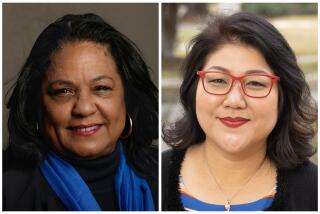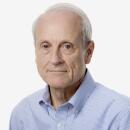Opinion: Which candidate can best revive L.A.’s once-great shopping district?
- Share via
The economic core of Los Angeles’ 8th Council District, where four candidates are fighting for a seat on the City Council, is Baldwin Hills Crenshaw Plaza – the first suburban shopping mall in the U.S.
The center embodies the hope and the heartbreak of this part of town. It was once the streamlined center of postwar commercial L.A., a symbol of optimism and gasoline-fueled freedom. Later it became the focus of the city’s emerging African American middle class, and later still a symbol of the demise of department stores. The empty Broadway become a Walmart, with all that the giant discount chain signifies – low prices, low wages, and the ongoing tactical and philosophical battle over how best to lift the fortunes of neighborhood.
An adjacent patch of land once known as Santa Barbara Plaza, and later Marlton Square, stands empty – as it has for decades.
Yes, I know. Wait. Back up. Baldwin Hills Crenshaw is the nation’s first suburban mall? Those are fighting words, at least to pop culture historians who make pilgrimages to places like Southdale in Edina, Minn., and Northgate in Seattle, shopping icons of the 1950s.
But sorry. Baldwin Hills Crenshaw came first.
In the 1940s, Baldwin Hills was the ‘burbs, and Crenshaw Boulevard was its heart. Rich folks lived up in the hills, the only slightly less well-to-do in a new Spanish-Colonial-themed development known as Leimert Park, and the middle-class families in tidy homes elsewhere in the flats, away from the urban ills of downtown.
There was money there, and the Broadway department store chain – named after the downtown street where the flagship store opened – saw its future on Crenshaw. In 1947 it opened a store featuring a crazy Art-Deco fin, calculated to draw the attention of drivers. Developers included a collection of adjacent chain stores.
The May Co. had already expanded from downtown to the Miracle Mile in 1939, when it opened its iconic building with its rounded black-and-gold corner. But the company also had its eye on Crenshaw, and in an almost unheard-of challenge, it opened a store right across the street from the new Broadway.
At first, the two department stores glowered angrily at each other across what was once known as Santa Barbara Avenue. The customers loved it and came in droves, shopping at first one, then the other, then the adjacent grocery stores and boutiques. It was a mall by accident. But it worked.
The competitors realized they had a good thing going and began cooperating. Developers took notice and began building this kind of place on purpose – integrated malls with big department store anchors linked by smaller shops and featuring food courts. Sure, Southdale and Northgate were planned, enclosed and air conditioned. But it all started here.
The 8th District has some seriously troubled areas, many of them farther east, for example along Western Avenue, where activists fight motels that rent by the hour to accommodate sex traffickers and drug dealers, and Vermont Avenue, where huge lots have remained vacant since the fires and violence of 1992. Crenshaw, by comparison, is thriving, revived in part with the opening of a stop on Metro’s Expo Line in 2012, full of hope for the opening of the Crenshaw Line connection to LAX in four years. Metro construction keeps some streets closed and lends the area a sense that it is wrapped in a cocoon.
City Council candidates must explain what they expect to emerge when the construction barriers are removed. What do they want to create here, and how will they do it? Will the Crenshaw-Expo crossing further gentrify Leimert Park, and would that be good or bad? Should Crenshaw recapture its role as a driver’s paradise or will the area feature new-style transit-oriented development? Is there a place here for affordable housing? Will all of this renewal bring jobs to local residents? And how will progress here help fill the vacant lots and shut down the sex trafficking farther east?
The four candidates – Bobbie Jean Anderson, Robert L. Cole Jr., Marqueece Harris-Dawson and Forescee Hogan-Rowles – will try to answer those and other questions Saturday morning at 10 a.m. at a candidates’ forum hosted by the Empowerment Congress Central Area Neighborhood Development Council at the Barack Obama Global Preparation Academy at 1700 West 46th St., at Western.
Follow me @RGreene2
More to Read
Sign up for Essential California
The most important California stories and recommendations in your inbox every morning.
You may occasionally receive promotional content from the Los Angeles Times.











